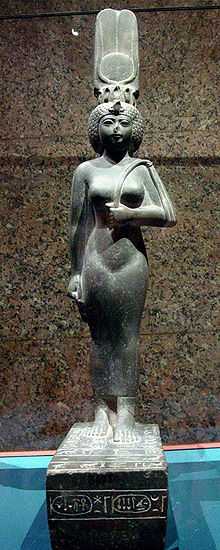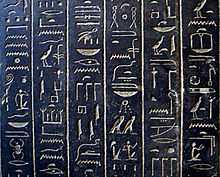Ankhnesneferibre
| Ankhnesneferibre | |||||
|---|---|---|---|---|---|
|
God's Wife of Amun Divine Adoratrice of Amun | |||||
 Statue of the God's Wife of Amun Ankhenesneferibre, now in the Nubian Museum, Aswan. CG-42205 | |||||
| Issue | None | ||||
| |||||
| Dynasty | 26th Dynasty of Egypt | ||||
| Father | Psamtik II | ||||
| Mother | Takhuit | ||||
| Died | Thebes | ||||
| Burial | Medinet Habu | ||||
| Religion | Ancient Egyptian religion | ||||
| ||||||||||||
| Ankhnesneferibre in hieroglyphs |
|---|
Ankhnesneferibre held the office of Divine Adoratrice of Amun (or God's Wife of Amun) during the 26th Dynasty of Egypt from around 586 to 525 BC. During the same time, she also held the office of God's Wife of Amun, which was the highest office in the priesthood of the temple of Amun in Thebes.

The title, Divine Adoratrice of Amun, conveyed even more political authority than the earlier office especially during the Late Libyan period through to the Kushite Dynasty 25 and saite Dynasty 26 period. Ankhnesneferibre was the daughter of Psamtik II and his wife Takhuit. Ankhesenneferibre was dispatched to Thebes and adopted by her predecessor in this office, Nitocris I as a stela from Karnak records.[1] Eight years later, in Year 4 of her brother Apries's reign (c.586 BC), she formally assumed the office of Divine Adoratrice of Amun herself when Nitocris I died.[2] Henceforth, she would govern Thebes for a period of 60 years until the Persian conquest of Egypt in 525 BC.[2] After the Persians captured Egypt, the office of the Divine Adoratrice of Amun was abolished and Ankhnesneferibre disappears from history. She is depicted in a number of statues and her black basalt sarcophagus was subsequently reused in Deir el-Medina during the Ptolemaic period by a man named Pymentu.[3] Her sarcophagus is today located in the British museum.[2]
Ankhnesneferibre's tomb can be found in the complex of Medinet Habu.
References
| Wikimedia Commons has media related to Ankhnesneferibre. |
| Preceded by Nitocris I |
God's Wife of Amun 586–525 BCE |
Succeeded by office abolished |
| Preceded by Nitocris I |
Divine Adoratrice of Amun 595–525 BCE |
Succeeded by office abolished |